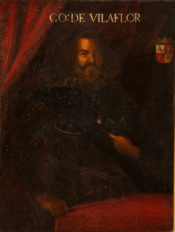Battle of Ameixial facts for kids
Quick facts for kids Battle of Ameixial |
|||||||
|---|---|---|---|---|---|---|---|
| Part of Portuguese Restoration War | |||||||
|
|||||||
| Belligerents | |||||||
| Commanders and leaders | |||||||
| Strength | |||||||
|
17,000 (3,000 from British Isles):
|
18,500:
|
||||||
| Casualties and losses | |||||||
| More than 1,000 Portuguese killed 100 English casualties |
4,000 killed All the artillery captured |
||||||
The Battle of Ameixial was a very important fight during the Portuguese Restoration War. It happened on June 8, 1663. The battle took place near a small village called Santa Vitória do Ameixial in Portugal. This area is about 10 kilometers (6 miles) northwest of Estremoz. It was a big clash between the armies of Spain and Portugal. In Spain, this battle is often known as the Battle of Estremoz.
Contents
Background to the Battle
In the spring of 1663, Spain launched its most successful attack on Portugal since the war began. The Spanish army was led by John of Austria the Younger. He was the son of Philip IV of Spain. John of Austria had already won battles in other places like Catalonia and the Kingdom of Naples.
His army marched into southern Portugal. On May 22, they captured the important city of Évora. This victory opened the way for them to march towards Lisbon, the capital city. Lisbon was only about 135 kilometers (84 miles) away.
Armies Prepare for Battle
Even though the Spanish army had captured Évora, they faced problems. They were running low on ammunition, food, and money. This stopped their advance. Meanwhile, the Portuguese gathered a large army of about 17,000 soldiers.
The Portuguese army was led by Sancho Manoel de Vilhena. He had help from other skilled officers. These included Frederick Schomberg, 1st Duke of Schomberg and Fernando de Meneses, 2nd Count of Ericeira. They marched to face the Spanish forces.
The Spanish commander, John of Austria, decided to pull back. He moved his army to a strong position northeast of Évora. He left about 3,700 soldiers to guard Évora.
The Portuguese army also received help from England. Three regiments, totaling about 3,000 soldiers, joined them. Most of these troops were from the British Isles. They were placed under the command of Duke Schomberg. A small number of soldiers from France also joined. About 2,000 English soldiers fought at Ameixial. Around 1,600 were infantry (foot soldiers) and 300 were cavalry (horse soldiers).
The Battle and Its Outcome
During the battle, a very important event happened. The personal flag, or standard, of Don John of Austria was captured. This happened when his group of soldiers was almost completely defeated. The captured flag was later given to King Afonso VI of Portugal himself.
The Spanish army suffered heavy losses. Many of their soldiers were killed. All of their cannons and supplies were captured by the Portuguese. The Spanish army had to retreat all the way back to Badajoz in Spain.
The Spanish soldiers left behind in Évora surrendered on June 24, 1663. This meant the entire Spanish attack on Portugal had completely failed. This victory helped secure the independence of the Kingdom of Portugal. It also marked the end of John of Austria's military career.
Remembering the Battle
A special stone was placed at the battle site to remember this important event. The battle is also shown in a famous azulejo (a type of painted tile artwork). This artwork is in the Room of the Battles at the Palace of the Marquises of Fronteira. It was created between 1671 and 1672.
See also


